






Why does decommissioning a nuclear power plant require the most sophisticated and highest-value PPE? Which activities contribute the most revenue? How are PPE product segments providing protection against radioactivity and other hazards such as physical, thermal, and electrical?

Explore key end-use sectors like F&B, dietary supplements, personal care and cosmetics, animal feed additives, and pet nutrition ingredients. Examine key imperatives like geopolitical chaos, key themes for suppliers like sustainability, and top consumer priorities like health.

What is the expected revenue and growth rate for segments like latex and synthetic gloves and sub-segments like powder-free latex and polyisoprene gloves? How will the price-sensitive regions and the increased adoption of eco-friendly and biodegradable products drive this industry?

The Sheconomy impacts almost every economic sector because a more significant proportion of highly educated women are joining the global workforce every year. With the increase in spending power, women are propelling economic activity from both ends—accelerating growth as a workforce and featuring as promising retail consumers. However, this female-powered economy is more than a mega trend for leveraging the economy. It is a massive force that addresses the inequalities women have faced at home, in society, and in their workplaces for generations.
Schedule a dialog or email us at myfrost@frost.com to connect with an industry expert at no charge. We are taking unprecedented action to make our team available to help you cut through the media and politics to get factual one-to-one guidance for the issues and opportunities that matter most to your business.

How are factors like material substitution potential impacting this industry’s size?
Read more Request Info
Analyze key material types like polyvinyl chloride, polyurethanes, HPPs, and more
Read more Request Info
How are the workplace hazard concerns and stricter safety protocols driving demand?
Read more Request Info
What are the revenue forecasts for each product group, end application, and region?
Read more Request Info
Examine the convergence of digital technologies and regenerative farming practices
Read more Request Info
How is the adoption of PaaS and rental platforms enhancing product penetration?
Read more Request Info
How much revenue do large product segments like protective clothing account for?
Read more Request Info
Explore the elastomers, fluids, resins, gels, and application methods in this sector
Read more Request InfoDespite the commercialisation of new technologies, there is still a significant gap, especially if we want to reach the sustainability goals set for 2050. One of the other options to close this gap is to change consumer behaviour and reduce plastic consumption. In some cases, this is feasible and even desirable. But in other cases, it could mean sacrificing something (a piece of packaging, for example) that actually does an important job, like reducing food waste.
Read more
Agricultural markets are hurting because of this, mainly because Russia and Belarus are key players in the industry, as they are among the biggest global exporters of both fertilizers, and important food commodities like grains and oilseeds. Also, they export the chemicals that are used to fabricate fertilizers, like potassium, ammonium, and phosphorus. Higher natural-gas prices have also increased prices for fertilizers, as it’s a crucial element in their fabrication.
Read more
Leveraging key transformational technologies and trends driving emerging opportunities was the underlying theme at Frost & Sullivan’s recent event, “Asia Pacific Perspective: What are the Transformational Opportunities in 2022?” It featured key insights into critical developments impacting industries such as energy, healthcare, aerospace & defense and technology. Participants also had the chance to listen to an in-depth panel discussion highlighting the key trends in healthcare.
The 12th edition of Frost & Sullivan and The Energy and Resources Institute (TERI)’s Sustainability 4.0 Awards took place virtually on Jan. 12, 2022. The awards recognized companies embedding sustainability with economic value creation, thereby creating value for all stakeholders, building a safer environment, and ensuring a stronger community.
Frost & Sullivan’s recent analysis, Global 3D Printing Materials Growth Opportunities, finds that the global 3D printing materials market is projected to reach $3.18 billion by 2027 from $1.33 billion in 2020 at a compound annual growth rate of 13.3%. The market is driven by the growing acceptance and deployment of 3D printing technologies in product design and development functions.